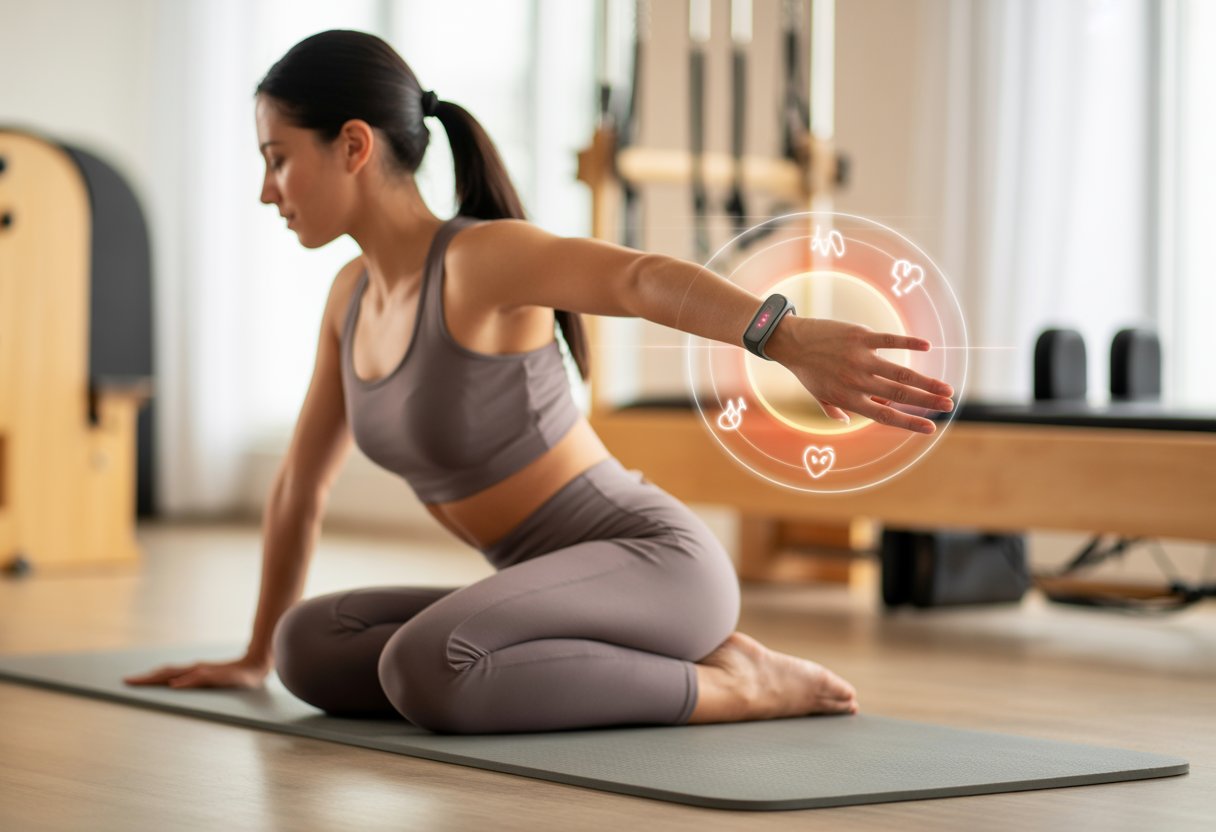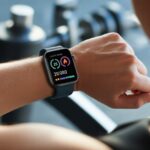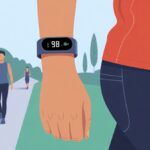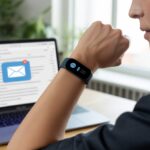Let’s be real: there’s something so satisfying about seeing our Pilates sweat session actually show up as more than “unknown activity” on our fitness trackers.
When we use a fitness tracker for Pilates, we can finally see our sessions measured, track our progress, and figure out if those hundred pulses are really doing anything for us.
No more guessing if that last set of roll-ups was worth the effort.

With a good setup, our trackers can log Pilates as an actual workout, count calories burned, and maybe even surprise us with how active we’ve been. That’s the validation we’ve all wanted.
Devices like Fitbit or Garmin watches let us pick Pilates as an activity, so our sweat doesn’t just disappear into the yoga void.
If you’re curious about comparing trackers, there’s some solid advice in this Reddit thread on best trackers for Pilates and more.
If you’re ready to see real numbers from your mat or reformer sessions, it’s time to set up your tracker for Pilates.
It’s honestly way more motivating to stick with it when you know every session is getting counted—one roll-up at a time.
Getting To Know Your Fitness Tracker
Let’s be honest, most of us have used our fitness tracker as a glorified watch more than a Pilates buddy.
But with the right features and a bit of setup, that thing on our wrist can actually improve our workouts.
Key Features For Pilates
Pilates isn’t a step-counting contest, so we can skip marathon-level metrics.
For our sessions, the most useful features include:
- Heart Rate Monitoring: This shows how hard we’re actually working during those slow, sneaky-tough moves. If you want accuracy, look for chest strap compatibility, like with some advanced smartwatches and fitness trackers.
- Activity Recognition: Trackers like Fitbit’s Inspire 3 can auto-detect Pilates or let us pick a “Yoga” or “Workout” mode for logging.
- Calories Burned: Most trackers give us an estimate, but honestly, take it with a grain of salt—Pilates isn’t all jumps and sprints.
- Session History: This helps us see progress and count how many times we’ve powered through “the hundred.”
- Ease of Use: If setup takes longer than our Pilates session, maybe it’s not the right tracker.
Setting Up Your Device
First things first, let’s make sure our device is charged.
Nothing kills the Pilates vibe faster than a dead battery.
Most fitness trackers—Fitbit, Garmin, Apple Watch—come with an exercise app or workout mode we need to set before we begin.
- On Apple Watch, scroll to the Workout app and tap the closest thing to Pilates (usually Yoga or Mind & Body).
- With Fitbit Inspire 3, we can load specific exercises and move them to the top of the list so we don’t have to swipe with sweaty fingers. The Fitbit Community has some helpful tips for customizing quick-access exercises.
Wear the tracker snug on your wrist (or chest, if you’re using a strap).
Loose bands mess up heart rate readings. Double-check that you’ve set it to track the right activity—nobody wants their Pilates logged as a “run.” Our toes would not approve.
Choosing The Right Tracker
Let’s face it, not all trackers are the same.
Some of us want a basic band, while others want a full-on smartwatch with all the data and maybe a tiny confetti cannon after a tough class.
- The best fitness trackers for Pilates have good heart rate tracking, manual entry for custom workouts, and easy syncing to our phones.
- Fitbit Inspire 3 is perfect for beginners—super easy, solid heart rate monitor, and affordable.
- Garmin devices usually give us more data and are popular with folks who love workout stats.
- Apple Watch is versatile, tracks tons of activities, and the workout app is really easy to use.
- Fancier smartwatches might add GPS and extra metrics, but let’s be real, we’re stretching here—not running a marathon (unless we’ve totally misunderstood Pilates).
Think about what matters most—simplicity, data, battery life, or just matching your leggings.
And if your tracker tries to coach you through burpees during Pilates, time to change those settings.
Preparing For Pilates With Technology
Using tech for Pilates means we can track progress and actually remember how many leg circles we did—even when our brains are fried.
Getting started is all about setting up our gadgets so everything works together like a well-oiled Pilates teaser.
Configuring Fitness Apps
First, pick a fitness app or tracker that gets Pilates isn’t just running in slow motion.
Devices like Fitbit, Apple Watch, and Glo can track Pilates if we select the right workout mode.
With a Fitbit Charge 6, for example, we just pick “Pilates” or “Yoga” to get data that makes sense (and doesn’t confuse our plank for a push-up).
It helps to turn on features for heart rate, calories, and workout duration.
A lot of apps let us set reminders so we don’t skip class—even if Netflix is calling. If we need motivation, we can join challenges and compete with friends (even the ones who think stretching is a spectator sport).
Before we hit the mat, it’s smart to check our app’s settings.
Making sure it records Pilates correctly means we can see progress without wondering why our step count spiked during leg circles. For more details on how trackers measure Pilates, check out this Pilates fitness tracker guide.
Syncing With Health Platforms
Syncing our fitness app with a health platform puts all our Pilates stats in one place.
This could be Apple Health, Google Fit, or even a secret spreadsheet we only show our dog.
To link devices, just follow the steps in your app.
Syncing lets us see sleep, stress, and how our Pilates habit affects everything else. It’s like piecing together the world’s calmest jigsaw puzzle—one deep breath at a time.
Most apps ask if they can share data with the big platforms.
We just say yes (and maybe cross our toes for luck). Now, everything from calories burned to heart rate trends shows up across our devices, making us feel like fitness pros—even if we still shake during teaser.
Some gadgets and apps break down our performance with charts, trends, and gentle nudges when it’s time to move.
Want to use your wearable for more than just telling time? Check out this guide on monitoring Pilates with wearable watches for more inspiration.
Tracking Your Pilates Workout
It’s easy to let a Pilates class fly by without really knowing how hard our heart is working, how many calories we’re burning, or which move made us sweat the most.
But with the right tricks, our tracker can turn those mysteries into data we can actually use.
Selecting Pilates Mode
First, check if your fitness tracker has a Pilates mode.
A lot of newer models, like the Garmin Vivoactive and some Apple Watches, now include a Pilates workout setting. This lets us log Pilates specifically, so we don’t have to pretend we just went for a jog in our Pilates socks.
If there’s no Pilates option, don’t panic.
We can usually pick something close—like “Yoga” or “Other Workout.” Some trackers let us customize or add Pilates in the app. For example, some devices sync Pilates classes directly so everything lands in the right spot. When we pick the right mode, our data gets way more accurate.
Understanding Your Metrics
Looking at the numbers after Pilates can feel like reading a weather report in another language.
But a few stats matter: heart rate, calories burned, and duration.
Pilates works the whole body with lots of holding and stretching, so our heart rate probably won’t spike like it does in HIIT, but it should climb above couch-potato level.
If we want the most accurate heart rate—especially during mat work—we might try a tracker that pairs with a chest strap, as some users suggest.
It’s a good idea to check average calories and activity time, so we know if Pilates is burning off dessert or just our patience.
Monitoring In Real Time
Real-time feedback isn’t just for checking if our ponytail’s still in place.
Watching our stats during Pilates helps us adjust intensity on the fly.
Most trackers show heart rate, time, and sometimes active zones right on the screen.
If our heart rate is too low—like, popcorn-munching low—it’s probably time to squeeze those glutes harder.
Some apps let us pause or end a session without messing up our data.
This is a lifesaver if our cat decides to join in mid-workout. Vibration alerts can remind us to switch moves, drink water, or gasp for breath (depending on the instructor’s idea of “gentle Pilates”).
Real-time data keeps us in control and makes each Pilates session as precise as our best teaser.
Interpreting Results And Metrics
If we want to know whether our Pilates routine is actually working, we have to decode all those numbers our tracker throws at us.
These metrics help us tweak our workouts, target our core, and maybe even prove we’ve earned that extra snack.
Analyzing Performance Data
Let’s be real—sometimes after a Pilates session, it feels like we just lounged around with extra flair. That’s why performance data keeps us on track.
Our trackers scoop up all sorts of numbers: heart rate, calories burned, and how long we hold each move.
Key metrics to watch:
- Heart Rate: If you want to boost cardio or shed a few pounds, keeping tabs on your heart rate zones matters.
- Calories Burned: We all peek at this, but honestly, calorie math isn’t the magic answer to everything.
- Balance & Flexibility: Some trackers even check how wobbly we get or track how our mobility changes.
If you geek out on data, wearable watches can show real-time feedback. We can look at graphs and scores to see when our energy dips or when we should push a little more.
Smart systems like Flexia give us progress scores, which make setting goals feel way less overwhelming. You can dig into more details about smart Pilates metrics if you’re curious.
Core Strengthening Insights
Who doesn’t want a stronger core? Fitness trackers go beyond step counts—they help us see how our core strength is shaping up.
Since Pilates is all about control, the tracker can reveal if we’re getting steadier or stronger with every session.
Some trackers check repetition quality or pick up on those tiny shakes that basically shout, “my core’s tired!” A few high-end ones track muscle engagement, but for most of us, heart rate and workout length are good enough as stand-ins.
If our tracker syncs with an app, we might get little gems like, “Your core was stronger Thursday than Monday.” That’s a solid reason to roll out of bed, right?
Wearables let us spot trends and set weekly goals, so we’re not just flopping around for nothing. For more on using smart wearables in Pilates, check out Pilates and wearable watches.
Optimizing Your Pilates Routine
Using a fitness tracker for Pilates means we actually see progress and can tweak our routine. It’s more like a fun experiment than just winging it.
Every plank, every resistance band stretch, suddenly counts toward real goals—not just trying to out-step your neighbor.
Using Metrics To Set Goals
Let’s face it—if we don’t measure, we’re just guessing. Our tracker grabs data like calories burned, heart rate, and how long we worked out.
These numbers help us set simple, clear goals. Maybe that’s more flexibility, a stronger core, or just making it through a session without toppling over.
Tracker apps usually let us log special moves or adjust class types, so every Pilates move gets credit.
We can also monitor sleep and recovery. That way, we show up to class more like warriors and less like zombies. It’s almost like carrying a personal trainer—just without the pep talks.
Adjusting Workouts For Progress
Once we see the numbers, we can actually make smart changes. If our heart rate stays flat, maybe it’s time to try harder moves or add a resistance band.
Looking at stats each week helps us fine-tune home workouts and focus on posture. We might spot sticking points or realize we’re secretly awesome at certain exercises—the proof’s right there on our wrist.
Watching progress over time keeps us motivated. There’s something satisfying about seeing those little bars climb—even if our cat is the only one cheering us on. For more ideas, check out this guide on tracking your Pilates improvement.
Integrating Pilates With Other Fitness Activities
Sometimes we want that Pilates stretch, but also want to break a sweat with something intense. If we pair our workouts right, we get the best of both worlds.
Mixing In HIIT And Other Classes
Let’s be honest, nothing feels quite like wobbling out of a Pilates class and jumping into HIIT. HIIT (High-Intensity Interval Training) packs in quick bursts that get our heart pumping, while Pilates builds core strength and flexibility.
Balancing both is key—otherwise, our legs might give out before the day’s over.
Here’s one way to mix it up:
| Day | Morning | Evening |
|---|---|---|
| Mon | Pilates class | Rest (Oh yes, please) |
| Wed | HIIT session | Stretching or Pilates |
| Fri | Reformer Pilates | Light cardio walk |
Pairing workouts like this helps us dodge injuries and keeps things interesting. Using a fitness tracker, we can watch our heart rate during HIIT and track calories burned during Pilates and other activities.
The best part? We never get bored, and our tracker never nags us with, “Are you still alive?” after a tough session.
Getting Support And Professional Guidance
Using a fitness tracker for Pilates isn’t just about counting reps or checking heart rate. Getting help from instructors or healthcare pros makes practice more effective—and a lot safer.
Leveraging Professional Instruction
Sometimes we need an instructor’s eye to save us from turning the mat into a wrestling match with gravity. Certified instructors can show us how to set up the tracker, so it doesn’t think we’re just snoozing in yoga pants.
Many trackers, like the Garmin Vivoactive, let us record Pilates as its own activity. If our tracker doesn’t, instructors can help us use another setting or log workouts by hand.
That way, our tracker gets it—we’re stretching, not flopping—and we get better stats on form, intensity, and progress.
Instructors can break down what those stats mean. What’s a good average heart rate during a leg circle, anyway? With their help, we use our tracker’s data to actually adjust our workouts, not just collect mysterious numbers.
Consulting A Healthcare Provider
Before you jump into Pilates—or honestly, any workout—with that shiny tracker on your wrist, you might want to chat with a healthcare provider first. They’ll help you avoid inventing a new Pilates move called “The Pulled Muscle Surprise.”
Healthcare pros can point out any movement risks, especially if you’ve dealt with injuries or have a chronic health issue. Sometimes they’ll even suggest tracker features to try, like heart rate alerts for a safer session.
If you’re on medication or managing a condition, their advice makes it way easier to tailor both your Pilates routine and your tracker’s settings to your needs. No need to guess or hope for the best.
Taking their input means you’re not just winging it in class. You’ll actually use your fitness tracker in a way that looks out for your health—no superhero cape required.
- Best Fitness Trackers for Kids Who Move Faster Than Your Wi-Fi - December 1, 2025
- How to use Bluetooth headphones with gym equipment without looking like a techno-ninja - December 1, 2025
- Best Smartwatches for Strava: Track Your Sweat in Style - December 1, 2025






